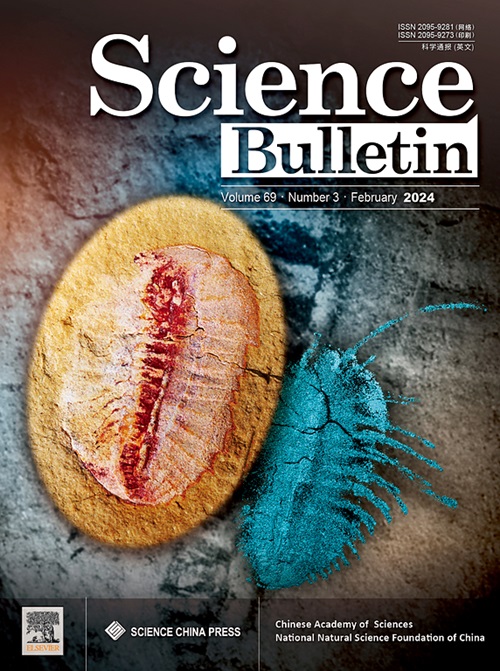Λ(1405)的极轨迹有助于确定其动力学性质。
IF 18.8
1区 综合性期刊
Q1 MULTIDISCIPLINARY SCIENCES
引用次数: 0
摘要
Λ(1405)一直是最具争议的外来重子之一。如果Λ(1405)具有两极分子结构,则这些极点将以不同的方式向SU(3)极限演化。从最近对I=0的πΣ-K的LQCD模拟的分析和对八重子质量的夸克质量依赖的研究中,我们第一次精确地确定了这些极点在Tr[M]=C轨道上指向对称点的轨迹。在mπ≃200 MeV处,我们的结果与晶格模拟结果一致,并且基于NLO手性拉格朗日量的物理点外推与已有的实验分析结果一致。我们预测了LO和NLO的质量相似的轨迹,与LO相互作用的优势相一致。在该轨迹的SU(3)对称点,两个极都在物理片上,下极位于E(1)=1573(6)(6) MeV处,成为SU(3)单线态,而高极位于E(8a)=1589(7)(5) MeV处,与八元体表示耦合。此外,我们对Σ *共振在I=1中作了预测。我们发现在这个扇区中有一个共振极在mπ=415 MeV附近演变成束缚态。这里提出的结果对于揭示奇异重子共振的分子性质至关重要,并且可以在未来的LQCD模拟中进行测试。本文章由计算机程序翻译,如有差异,请以英文原文为准。
Pole trajectories of the Λ(1405) help establish its dynamical nature
The has been one of the most controversial exotic baryons. If the possesses a two-pole molecular structure, these poles are expected to evolve differently towards the SU(3) limit. From an analysis of a recent LQCD simulation on the scattering for and the study of the quark mass dependence of the octet baryon masses, we determine for the first time the trajectories of these poles towards the symmetric point over the trajectory accurately. At MeV, our results are consistent with the lattice simulations, and the extrapolations to the physical point, based on the NLO chiral Lagrangians, agree well with existing experimental analyses. We predict qualitatively similar trajectories at LO and up to NLO, consistent with the LO interaction’s dominance. At the SU(3) symmetric point of this trajectory, both poles are on the physical sheet, and the lower pole is located at MeV, becoming a SU(3) singlet, while the higher pole at MeV couples to the octet representation. Moreover, we make predictions in for the resonance. We find a resonance pole that evolves into a bound state around MeV in this sector. The results presented here are crucial to shed light on the molecular nature of exotic strange baryon resonances and can be tested in future LQCD simulations
求助全文
通过发布文献求助,成功后即可免费获取论文全文。
去求助
来源期刊

Science Bulletin
MULTIDISCIPLINARY SCIENCES-
CiteScore
24.60
自引率
2.10%
发文量
8092
期刊介绍:
Science Bulletin (Sci. Bull., formerly known as Chinese Science Bulletin) is a multidisciplinary academic journal supervised by the Chinese Academy of Sciences (CAS) and co-sponsored by the CAS and the National Natural Science Foundation of China (NSFC). Sci. Bull. is a semi-monthly international journal publishing high-caliber peer-reviewed research on a broad range of natural sciences and high-tech fields on the basis of its originality, scientific significance and whether it is of general interest. In addition, we are committed to serving the scientific community with immediate, authoritative news and valuable insights into upcoming trends around the globe.
 求助内容:
求助内容: 应助结果提醒方式:
应助结果提醒方式:


